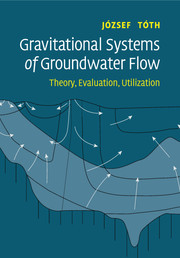Book contents
- Frontmatter
- Contents
- Preface
- 1 Introduction
- 2 The ‘Unit Basin’
- 3 Flow patterns in composite and heterogeneous basins
- 4 Gravity flow of groundwater: a geologic agent
- 5 Practical applications: case studies and histories
- 6 Epilogue: gravitational systems of groundwater flow and the science of hydrogeology
- Glossary
- References
- Appendices
- Appendix A
- Appendix B
- Index
4 - Gravity flow of groundwater: a geologic agent
Published online by Cambridge University Press: 31 July 2009
- Frontmatter
- Contents
- Preface
- 1 Introduction
- 2 The ‘Unit Basin’
- 3 Flow patterns in composite and heterogeneous basins
- 4 Gravity flow of groundwater: a geologic agent
- 5 Practical applications: case studies and histories
- 6 Epilogue: gravitational systems of groundwater flow and the science of hydrogeology
- Glossary
- References
- Appendices
- Appendix A
- Appendix B
- Index
Summary
Introduction
Chapter 4 is intended to advance the view that moving groundwater is the common basic cause of a wide variety of natural processes and phenomena and hence it should be regarded as a general geologic agent.
That groundwater plays an active role in certain geologic processes has been recognized in numerous earth-science subdisciplines for a long time. However, the generality of this role was not appreciated until the 1960s and 1970s, when the underlying common cause itself was sufficiently understood to allow, and indeed to stimulate, dedicated studies of its broader ramifications. That cause was the gravity-driven basinal flow of groundwater. Even during this period, however, the generalization of groundwater's role in nature was hindered by at least two factors. First, the diversity of natural phenomena related to groundwater flow effectively conceals a single common cause. Second, a lack of knowledge, or even awareness, of basinal groundwater hydraulics among specialists of various other disciplines prevents them from recognizing the cause-and-effect relation between regional groundwater flow and the particular phenomena of their interest. By way of illustrating the difficulty of envisaging a common origin, suffice only to list such diverse, and indeed in some cases disparate, natural phenomena generated and/or fundamentally shaped by groundwater flow as: soil salinization, continental salt deposits, regional patterns of groundwater's chemical composition, soil liquefaction, gullying, landslides, dry-land ice fields, geysers, positive and negative geothermal anomalies, lake eutrophication, base-flow characteristics of streams, bog- vs. fen-type wetlands, type and quality of plant species and associations, taliks in permafrost, roll-front and tabular uranium deposits, dolomitization of limestones, karst morphology, diagenesis of certain clay minerals, some sulfide-ore deposits, and certain types of hydrocarbon accumulations.
- Type
- Chapter
- Information
- Gravitational Systems of Groundwater FlowTheory, Evaluation, Utilization, pp. 91 - 127Publisher: Cambridge University PressPrint publication year: 2009
- 1
- Cited by



